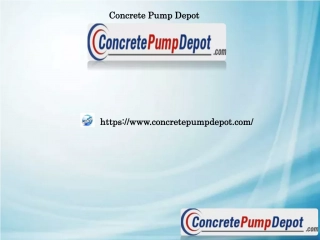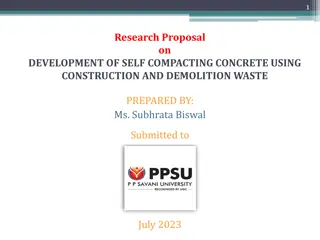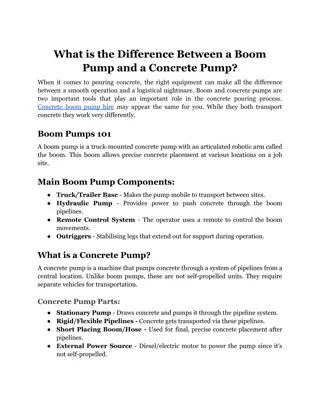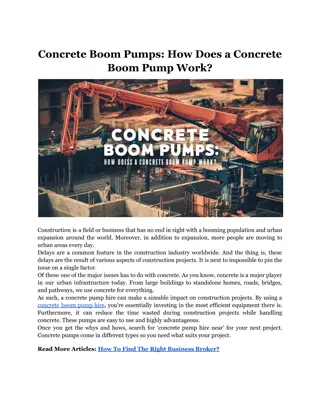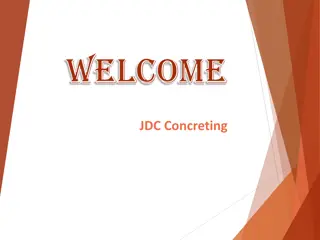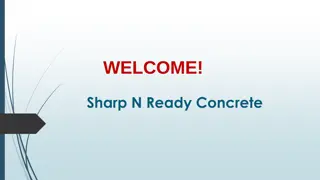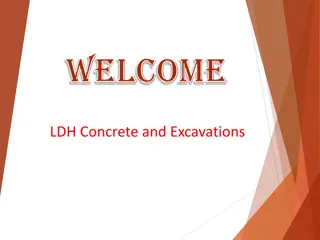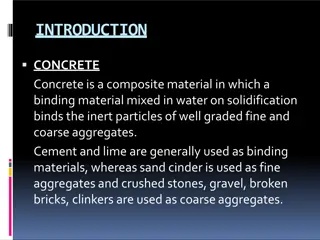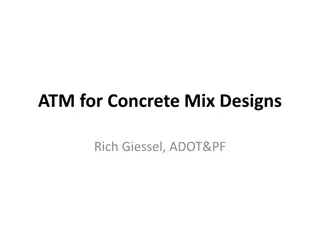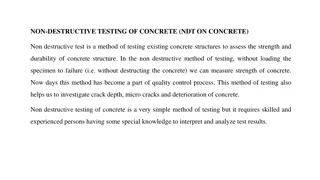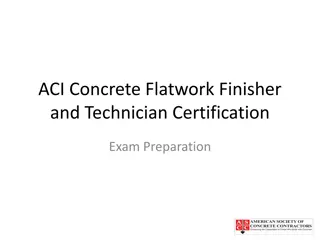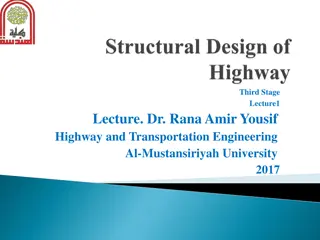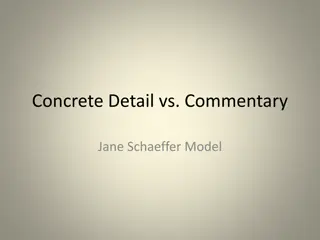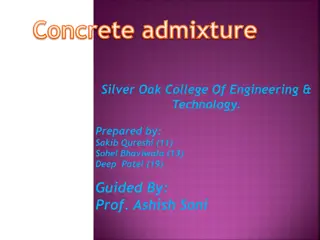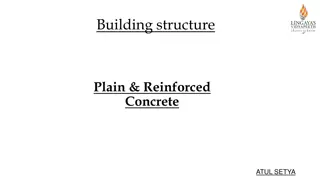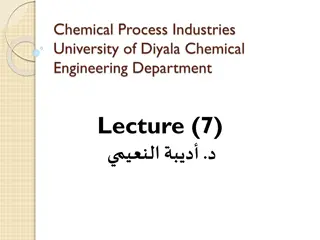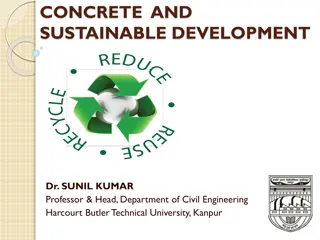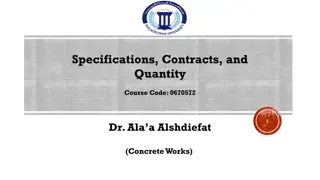Concrete Handling in Field: Essential Techniques and Equipment
This presentation by Nishant Singh Kushwaha covers the concrete handling process in the field, including batching, mixing, transportation, placing, compacting, curing, and finishing. It emphasizes the stages of producing concrete and highlights the importance of using the correct methods such as volume batching and weigh batching. The presentation also discusses different types of batching machines and provides insights into achieving homogeneous and consistent concrete mixes during the mixing process.
Download Presentation

Please find below an Image/Link to download the presentation.
The content on the website is provided AS IS for your information and personal use only. It may not be sold, licensed, or shared on other websites without obtaining consent from the author. Download presentation by click this link. If you encounter any issues during the download, it is possible that the publisher has removed the file from their server.
E N D
Presentation Transcript
Department of Civil Engineering Concrete Handling in Field By: Nishant Singh Kushwaha Subject Code: 4CE4-08 1
Concrete Handling in field This Powerpoint presentation covers entire unit of Concrete handling in field. Most of the material covers in this ppt and rest if left please refer to M.S Shetty book.
Stages of producing concrete. (1) Batching (2) Mixing (3) Transportation (4) Placing (5) Compacting (6) Curing (7) Finishing 3
(1) Batching (a) Volume batching (b) weight Baching 4
Volume batching Volume batching is not good method Moist sand in loose condition weights less than the same volume of dry sand. Practiced for small work. For quality work ,weigh batching is practiced. 5
VOLUME BATCH Gauge box Various gauge boxes of different volumes are used. Length 33.3 cm 33.3 cm Width 30 cm 30 cm Depth 20 cm 25 cm Volume 20 liters 25 liters Grade Cement- kg Sand -lts Coarse Aggregate lts 70 1:11/2:3 (M 200) 1:2:4 (M 150) 1:3:6 (M100) 50 35 50 70 140 50 105 210 6
Weigh batching Weigh batching is correctmethod Facilitates accuracy, flexibility & simplicity Different batching machine are available : (a) manual machines & (b) Automatic machines Manual machine : Has two buckets Buckets mounted on common spindle about which theyrotate. One is loaded while other is discharged in mixer. Spring loaded dials indicate the weight. 8
Automatic weigh batch For large works Over head hopper and discharges into mixer. Useful in ready mix concrete plant Recorders for weight Calibration is required from time to time. 9
(2) MIXING Mixing of cement,sand aggregates should ensure that: The mass is homogeneous Uniform in color consistent 10
MIXING METHODS : (1) Hand mixing (2) Machine mixing 11
Hand mixing Practiced for small scale work (small house, repairing of house etc) 10 % extra cement is added to compensate inferior concrete produced by this method. Spread fine & coarse aggregate in alternate layer Spread cement over it Mix with shovel till uniform color is achieved
Machine mixing Medium & large scale work use machine mixing Mixing is efficient, economical & produce quality concrete. Type of mixer: (a) Batch mixer : batch by batch with time interval (b) Continuous mixer: continuously mixed & discharged (in dam construction) 13
CONCRETE MIXER (1) Pan type (2) drum Type: (a) tilting (b) Non tilting (c) Reversing 14
PAN MIXER 15
PAN MIXER A forced movement pan mixer has blades that are fixed to an assembly that agitates the concrete throughout the pan as the vertical shaft rotates. 16
DRUM MIXER As per IS: 1791-1985 mixers are designated by number which shows capacity (liters) of batch: a) Tilting : 85 T, 100T, 140 T, 200T b) Non tilting : 200 NT,280 NT, 375 NT, 500 NT, 1000 R c) Reversing : 200 R, 280 R, 375 R,500 R, 1000 R T= Tilting, NT =non tilting, R=Reversing 17
TILTING MIXER Internal blades lift and tumble the ingredients onto itself. Two primary types exist: horizontal (one end has and opening for charging and a different end for discharging) single drum (materials are charged and discharged through a single opening). 19
NON TILTING MIXER Single drum rotating about a horizontal axis. Fixed blades work the concrete towards the discharge end of the mixer, in order to provide a rapid rate of discharge. 21
REVERSING MIXER The entire drum rotates around its axis as materials are loaded through a charge chute at one end of the drum and exit through a discharge chute at the opposite end of the drum. Mixing blades are mounted on the inside surface of the drum and as the drum rotates the blades mix by lifting and dropping the materials during each rotation. Once the materials are sufficiently mixed the rotation of the drum is reversed and the blade arrangement pushes the concrete through to the discharge end of the mixer. 23
Sequence of charging drum First half quantity of coarse aggregate is placed in skip Over it half quantity of sand On that full quantity of cement Over it balance quantity of coarse & fine aggregates is place. This prevents spillage of cement in air while discharging in drum 24
25 % Water is placed in drum and then mix from skip is discharged in the drum This prevents sticking of cement on blades 75 water is immediately poured after placing mix material (cement sand etc) in drum. 25
Mixing time In small machine, mixing time varies between 1-2 minutes In Ready Mix Cement mixer 15-30 seconds RPM of drum : 15-20 Compressive strength of concrete increases with increase in mixing time but after 2 minutes increase in compressive strength is not sign Ki Af Si -2c 01a 2 nt. 25
If concrete is not used after mixing it may set But when concrete is agitated on time to time in drum setting time rule does not follow. 26
Retempering of concrete : Some time concrete from RMC plant is not delivered to site due to traffic congestion Concrete becomes stiff and becomes unworkable Site engineers can reject the concrete if delay is more If it can be of used then small volume of water is added and again agitated in the drum. This is called RETEMPERING OF CONCRETE. 27
MANUFACTURING OF CONCRETE With same material if care is not taken, resulting concrete will be bad concrete What are good rules to make good quality concrete. 29
TRANSPORTATION OF CONCRETE Precaution in concrete transportation: Homogeneity of conc. Mass is maintained Movement of hand trolly or truck on rough road surface makes vibrations This results in deposition of heavy aggregates at bottom of truck Water & cement slurry comes on top. 30
METHODS OF TRANSPORTATION Mortar Pan Wheel barrow Truck Mixer & dumpers Crane, Bucket & rope way Belt conveyors Chutes Skip & hoist Transit Mixer Pump & pipeline Helicopter 1. 2. 3. 4. 5. 6. 7. 8. 9. 10. 31
MORTAR PAN Common method in India More labour required Segregation of concrete is less Greater surface area of concrete is exposed to sun, concrete dries. 32
WHEEL BARROW When transportation of concrete is at ground level. Movement of wheel on rough road surface, segregates concrete. Some wheel barrows have pneumatic wheel to reduce vibration 33
CRANE Used for transporting concrete above ground level. For high rise buildings. Cranes are fast Can move horizontally & vertically Concrete in skip discharge from bottom In bucket concrete is discharged by tilting. 34
BUCKET & ROPEWAY Use for construction in: Valley Bridge pier in river Dam Advantage: Concrete is not exposed to sun or air & no loss of water. 35
Truck Mixer & dumpers Used for large concrete works. Can travel any part of site. Dumpers - 2-3 M3Capacity Trucks 4 M3Capacity Bottom surface of truck is kept wet Top of truck is covered to prevent evaporation 36
BELT CONVEYORS Limited use in construction Advantages: Can transport large volume Very quick Can go where access is limited Disadvantages : On steep slope concretesegregates. Exposed to sun for long time. 37
CHUTE For transporting from ground level to lower level. (basement etc). Used where labour can not reach due to less space in trench etc. Made of metal Slope should not be < 1 vertical : 2.5 horizontal. 38
SKIP & HOIST Labour can go upto 3rd or 4th floors. So skip is used for transport vertically up (in multistory building). Skip travels on vertical rail. Skip can discharge manually or automatically. 39
TRANSIT MIXER Used for long distance travel in RMC plant. Concrete is continuously agitated in truck drum (2 6 rpm). Also transported mix in dry condition and water is added on reaching the destination. Wet Mix in truck must reach site in 1- 1.5 hours. Pumps are also fitted on truck mixer to discharge concrete. 41
PUMPS & PIPELINE Most popular method Reliable & good quality pumps are used. Mostly operated by diesel. Concrete is placed in collecting hopper. Rotating blades in hopper pushes concrete towards pipe. Vacume in hose pipe (600 mm Hg) Rotating rollers in pump chambers squeeze the concrete in pipe and flow of concrete is started. Concrete is discharged from other end of hose pipe. Concrete can be pumped upto 400 m height and 2000 m distance. 42
PIPELINE Pipeline should : Have correct diameter as per pump pressure. (generally 125 mm) Have sufficient thickness Good couplings Poor pipeline can cause blockage. 44
PIPELINE Thumb rule : For 30 M3 /hr concrete and 200 m length, dia should be 100 mm. Length > 500 m then dia = 150 mm. Dia = 3 to 4 times the size of aggregate Leaky pipe & coupling result in escape of water /air & finally block the concrete. Vertical pipe should good otherwise difficult to change at height. Pump is kept at distance from building about 15 % of vertical length. KAS-2012 44
PUMPABLE CONCRETE Concrete which can be pushed through a pipeline is called pumpable concrete. Friction between pipe wall and concrete is less. Concrete flows in the form of plug which is separated from pipe wall by a thin layer of lubricating cement paste. Flow resistant must be < pump pressure. If the concrete is more wet then water comes out of mix which makes more resistance to flow. Stiff and also very wet concrete is not pumpable. 46
Design of pumpable concrete Concrete Mix is so designed that all material remain together. Mix must make redial movement of grout to maintain lubricating paste. Mix should be deformed at bends Cement & fine particles (0.25 mm size) are important for good flow. 350 to 400 Kg/ M3 of fine particles are necessaryfor flow. Slump of pumpable concrete is above 75 mm. 47
PROBLEMS IN PUMPING Blockage in pipe Pipe should be cleaned after each day operation Blockage can be cleaned by forward- backward pumping. Tapping pipe with hammer Clean pipe with rod or sponge ball pushed by compressed air. 48
PLACING CONCRETE Must be placed in systematic manner. Can be placed with following methods: Within earth mould : Foundation In timber plank formwork : Road, airport slab. Steel shuttering : Dam Under water 49
Concrete in Foundation In foundation, ground is made wet. Plastic sheet are laid between ground & slab Concrete is dumped not poured. No heap and dragging Placed in layers of 35 40 cm in mass concrete Avoid cold joints between 2 layers Surface of previous layer is cleaned with wire brush Sometime, cement slurry is placed on old surface Top of previous layer kept rough for good bond. 50


